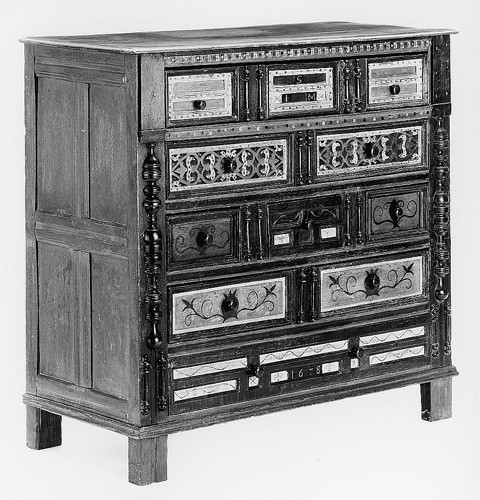
Chest of drawers, northern Essex County, Massachusetts, 1678. Oak, sycamore, maple, and tulip poplar with oak and sycamore. H. 42", W. 44 3/4", D. 19 7/8". (Courtesy, Winterthur Museum.)

Detail of the right large half-column on the chest of drawers illustrated in fig. 1.
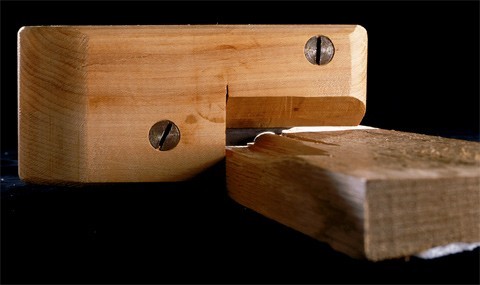
Modern scratch-stock made by Philip Ruhl, Quakertown, Pennsylvania, 2000. (Photo, Gavin Ashworth.)
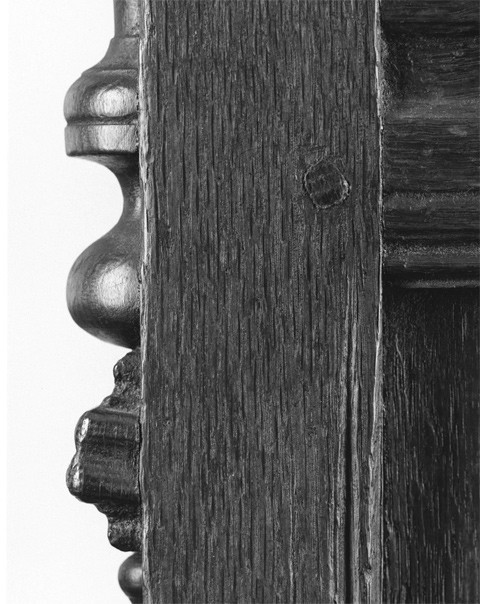
Detail of the stopped moldings produced by a scratch-stock cutter on the right side frame of the chest of drawers illustrated in fig. 53. (Photo, Gavin Ashworth.)

Detail of a “cup” illustrated in the 1611 London edition of Sebastian Serlio’s Five Books of Architecture. “Cups” or “Vessels” were usually depicted with feet and covers with finials.
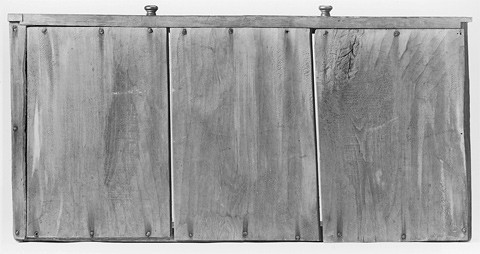
Detail of the water-sawn sycamore bottom boards of a drawer in the chest of drawers illustrated in fig. 1. Sycamore is difficult to rive and is water-sawn in all of the objects in the Essex County group.
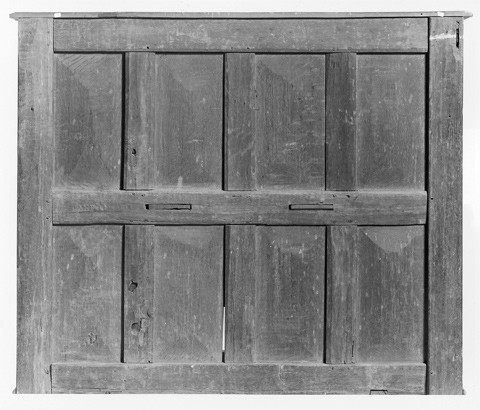
Detail of the back of the chest of drawers illustrated in fig. 1. The tenons of two drawer supports are visible on the center rail. These supports are for the middle tier of three drawers, an odd feature possibly specified by the patron.

Cupboard, northern Essex County, Massachusetts, 1680. Red oak, maple, sycamore, and tulip poplar, with oak and sycamore. H. 57 3/4", W. 50", D. 21 5/8". (Courtesy, Winterthur Museum.)
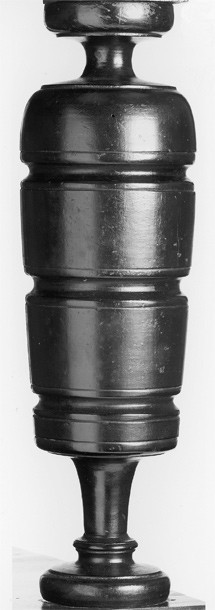
Detail of the upper right pillar of the cupboard illustrated in fig. 8.
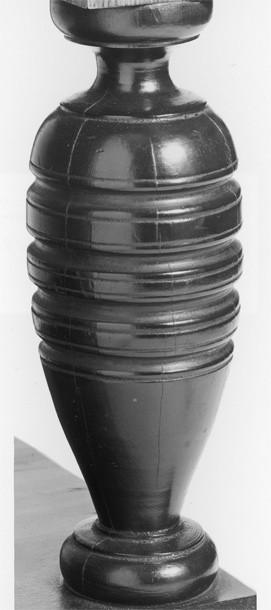
Detail of the lower right pillar of the cupboard illustrated in fig. 8.

Detail of the large half-column to the right of the door of the cupboard illustrated in fig. 8.

Detail of the large half-column at the right rear corner of the trapezoidal section of the cupboard illustrated in fig. 8.
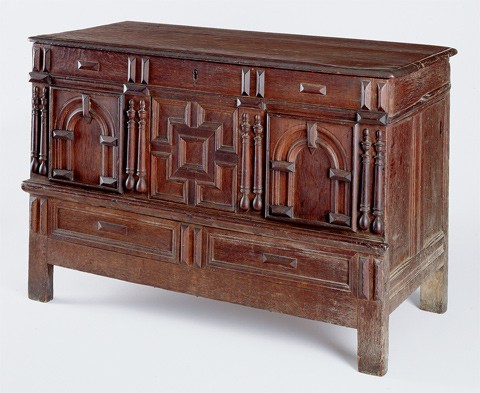
Chest, Boston, Massachusetts, 1660–1700. Oak, cedrela, and walnut with oak and white pine. H. 30 1/2", W. 45", D. 20 1/2". (Chipstone Foundation; photo, Gavin Ashworth.)
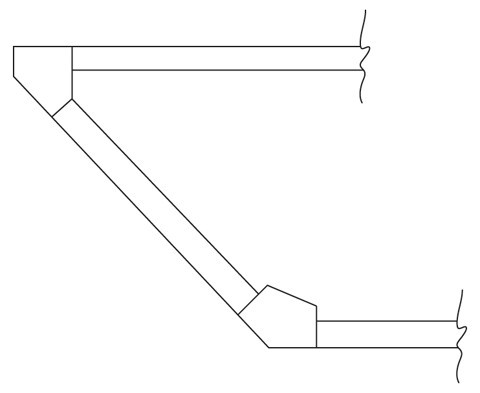
Drawing showing the framing of the trapezoidal storage compartment of the cupboard illustrated in fig. 8. (Drawing by Peter Follansbee; artwork by Wynne
Patterson.)

Drawing showing the framing of the jetty on the cupboard illustrated in fig. 8. (Drawing by Peter Follansbee; artwork by Wynne Patterson.)
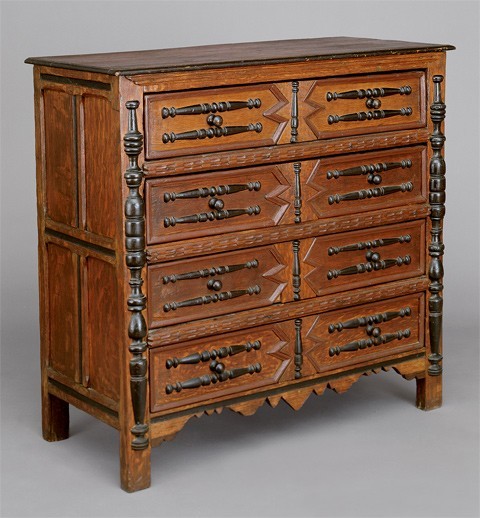
Chest of drawers, northern Essex County, Massachusetts, 1675-1685. Oak and maple with oak and pine. H. 44 1/4", W. 46 1/4", D. 20 5/8". (Courtesy, Peabody Essex Museum.) The piece has been dismantled, repinned, and glued, and the back of each drawer, the top of the case, and the crossetted central plaques on the drawers are replacements. Scribed layout lines for the original appliqués are still visible. About half of the bilaterally symmetrical sphere-and-column appliqués are restored. The original ones relate to those on the cupboard illustrated in fig. 17.

Cupboard, northern Essex County, Massachusetts, 1675–1685. Oak and maple with oak and pine. H. 58 1/2", W. 46 1/2", D. 20". (Private collection; photo, Gavin Ashworth.) The door, top, middle and lower shelves, upper pillars, and some applied ornaments have been restored based on related examples from the same shop. The feet of the cupboard are original, and they have long cylindrical necks like the finials on the half-columns of the chest illustrated in fig. 16. The cupboard is shown prior to restoration in Wallace Nutting, Furniture Treasury, 2 vols. (Framingham, Mass.: Old America Co., 1928), no. 458.
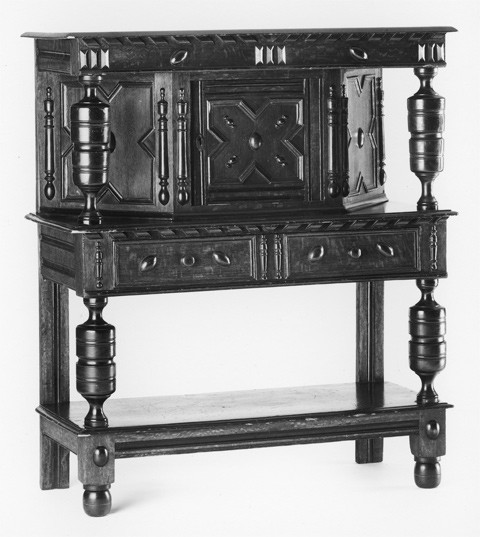
Cupboard attributed to the Harvard College joiners, Cambridge, Massachusetts, 1670–1700. Oak and maple with pine. H. 53 7/8", W. 46 5/8", D. 20 1/8". (Courtesy, Winterthur Museum.)

Detail of the shaped lower rail of the cupboard illustrated in fig. 17. (Photo, Gavin Ashworth.)

Detail of the lower right pillar of the cupboard illustrated in fig. 17. (Photo, Gavin Ashworth.)

Base of a chest of drawers or cupboard, northern Essex County, Massachusetts, 1681. Oak and maple with oak and sycamore. H. 44 1/8", W. 47", D. 22 1/4". (Courtesy, Harvard University.) The back and bottom boards, which constitute all of the surviving secondary wood, are water-sawn sycamore. The vertical back boards are set in grooves in the top rail and stiles and nailed to an inner lower rail. The pendants, small turned “bosses,” and half-columns on the overhanging stiles are replacements, whereas the half-columns on the door and stiles are original. The planed edge moldings on the lower rails are also period, indicating that the case never had an applied base molding.
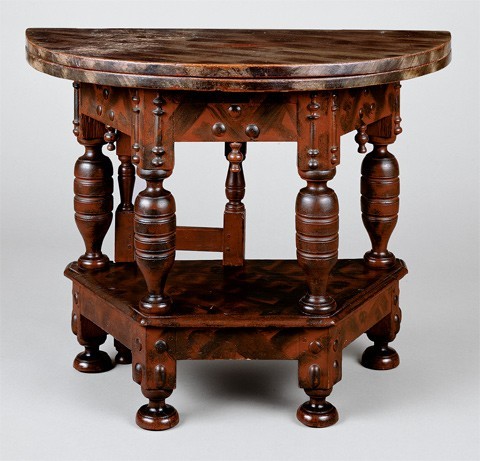
Leaf table, northern Essex County, Massachusetts, 1680–1685. White oak and maple. H. 28", W. 36 3/8", D. 35 5/8" (open). (Courtesy, Metropolitan Museum of Art, gift of Mrs. J. Insley Blair; photo, Gavin Ashworth.) The frame and bottom of the drawer is missing and the original front is fixed in place. The pendant under the left frieze is original. Similar drops were present on the addorsed brackets on five other objects attributed to this shop. Like the Staniford chest (fig. 1), the table has paint dating from the eighteenth century. The rails are mahoganized and the top is marbleized.
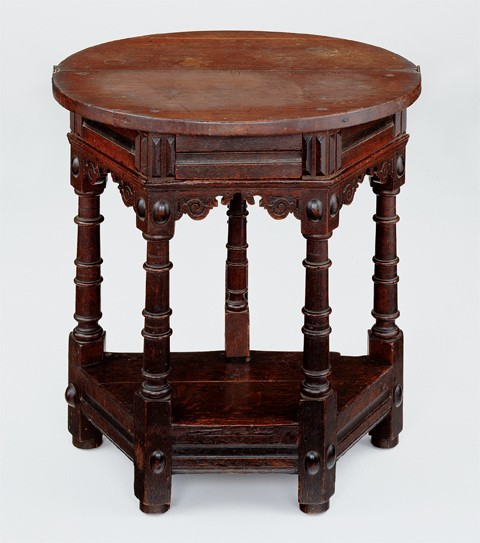
Leaf table, Boston, 1660–1680. Walnut, oak, cedrela, and maple with oak and white pine. H. 28 3/4", W. 28 3/4", D. 28 3/4" (open). (Chipstone Foundation; photo, Gavin Ashworth.)

Detail of the water-sawn board used for the shelf of the leaf table illustrated in fig. 22. (Photo, Gavin Ashworth.)
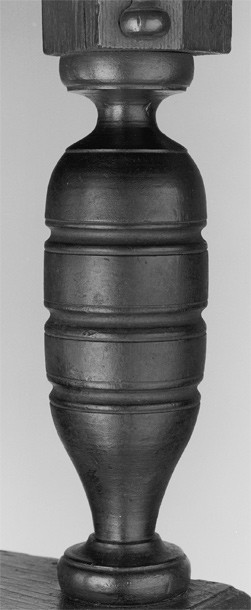
Detail of the right rear pillar of the leaf table illustrated in fig. 22. (Photo, Gavin Ashworth.) The pillars have tenons turned on both ends, exactly like those on cupboards in the Essex County group.
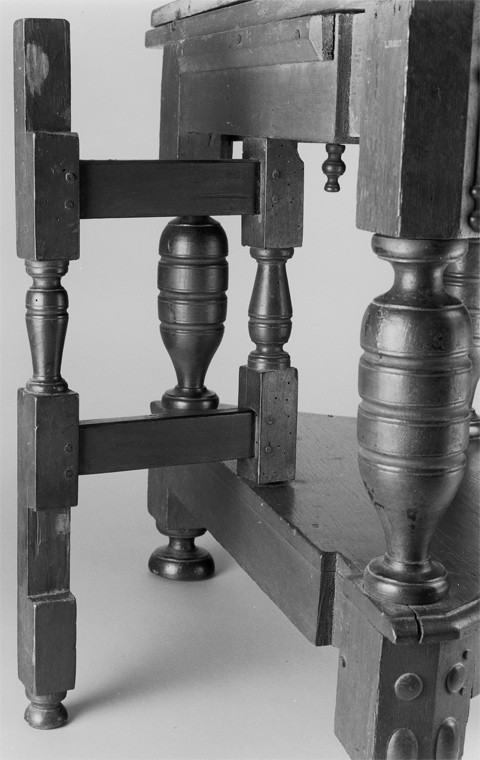
Detail of the fly leg of the leaf table illustrated in fig. 22. (Photo, Gavin Ashworth.)
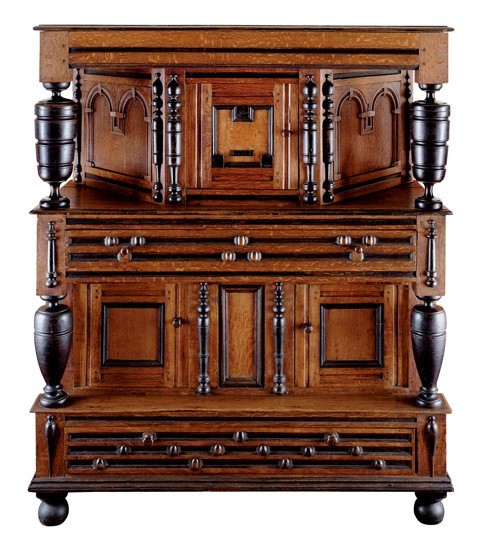
Cupboard, northern Essex County, Massachusetts, 1683. Oak, maple, and tulip poplar with oak and pine. H. 58 1/4", W. 49 1/2", D. 20 3/4". (Private collection; photo, Gavin Ashworth.) The joiner used riven oak for the frame members and panels and water-sawn oak for the top boards of the upper and lower cases. Traces of bright vermilion paint—probably red lead—survive on the arcades of the upper case.

Detail of the half-column to the left of the lower drawer of the cupboard illustrated in fig. 27. (Photo, Gavin Ashworth.)

Detail of the large half-columns to the left of the upper door of the cupboard illustrated in fig. 27. (Photo, Gavin Ashworth.)

Detail of the large half-column at the left rear corner of the upper storage compartment of the cupboard illustrated in fig. 27. (Photo, Gavin Ashworth.)

Detail of the large half-column adjacent to the left door of the lower storage compartment of the cupboard illustrated in fig. 27. (Photo, Gavin Ashworth.)
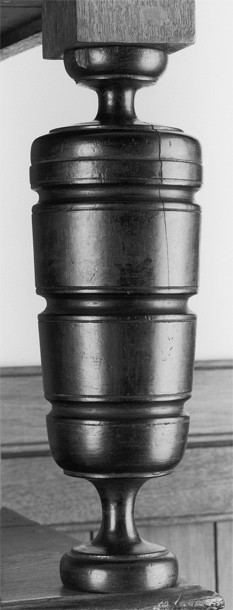
Detail of the upper right pillar of the cupboard illustrated in fig. 27. (Photo, Gavin Ashworth.)
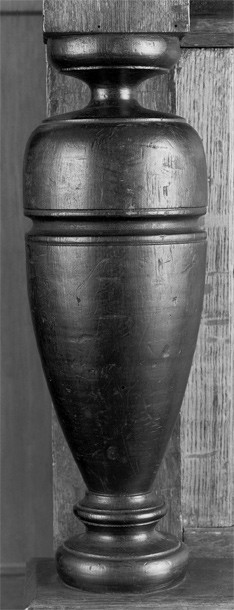
Detail of the lower left pillar of the cupboard illustrated in fig. 27. (Photo, Gavin Ashworth.)
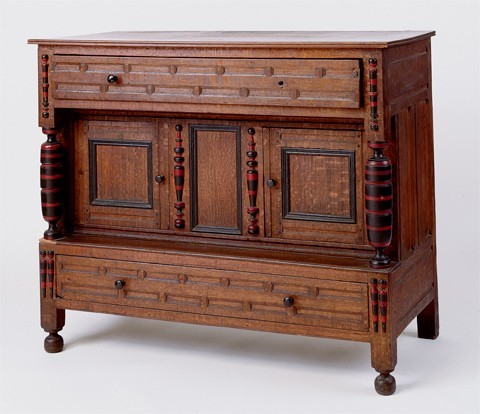
Base of a cupboard, northern Essex County, Massachusetts, 1685–1690. Oak and maple with oak. H. 38 5/8", W. 46 1/2", D. 20 1/8". (Courtesy of Historic New England, gift of Bertram K. and Nina Fletcher Little.)

Detail of the right pillar of the cupboard base illustrated in fig. 34. (Courtesy of Historic New England, gift of Bertram K. and Nina Fletcher Little.)
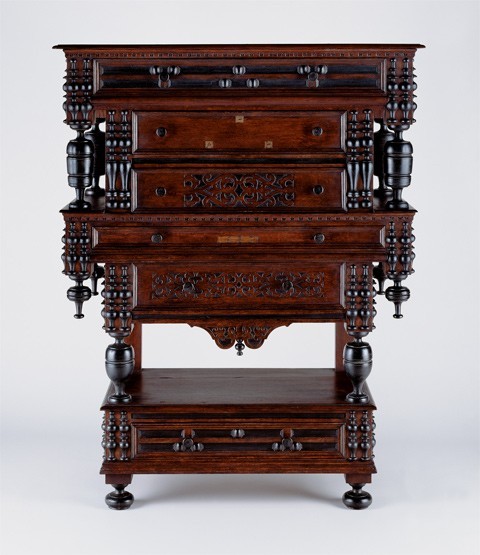
Cupboard, northern Essex County, Massachusetts, 1683. Oak and maple. H. 58 3/8", W. 46 1/4", D. 19 3/4". (Private collection; photo, Gavin Ashworth.) This is the earliest cupboard with a front jetty. It is shown prior to restoration in Sotheby’s Fine Americana and Silver, New York, June 17, 1999, lot 187.

Detail of the large upper pillar at the right front corner of the cupboard illustrated in fig. 36. (Photo, Gavin Ashworth.)
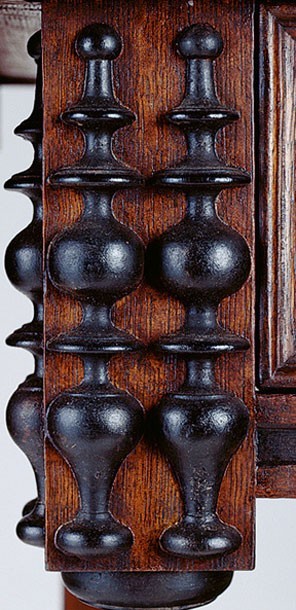
Detail of the small half-columns to the left of the lower carved drawer of the cupboard illustrated in fig. 36. (Photo, Gavin Ashworth.) The back surfaces of the original turnings have marks from a water-powered saw, frame saw, and plane.
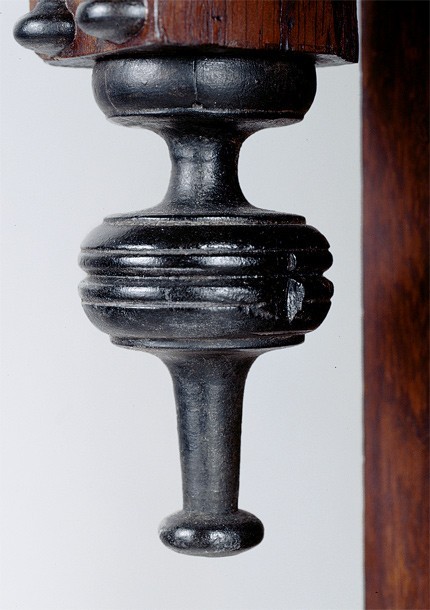
Detail of the left rear jetty pendant of the cupboard illustrated in fig. 36. (Photo, Gavin Ashworth.) The pendants on this cupboard are the boldest ones associated with this shop.

Cupboard, northern Essex County, Massachusetts, 1684. Oak and maple with oak. H. 53 5/8", W. 48 1/2", D. 20 3/8". (Courtesy, Winterthur Museum.) All of the oak secondary wood is riven. The perimeter moldings on the bottom drawer are missing, and the replaced knobs are not in the correct position. The lower stiles originally had half-columns on their front and side faces. The pendant appliqués of the arcades are missing and the glyphs decorating the imposts and plinths may be replacements. No other piece attributed to this shop has glyphs. The front feet match those of the Woodbury cupboard (fig. 8) and are integral with the stiles.

Detail of the back of the upper case of the cupboard illustrated in fig. 40.
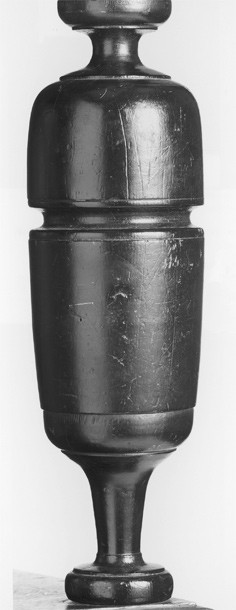
Detail of the upper right pillar of the cupboard illustrated in fig. 40. The square shouldered pillars produced by this turner are exceptional, featuring dramatic transitions from thick to thin. They are usually found on upper cases and are the major forms in this shop’s turning hierarchy. Tapered baluster-shaped pillars like those shown in fig. 43 are more commonly found on the lower sections of furniture from this shop.
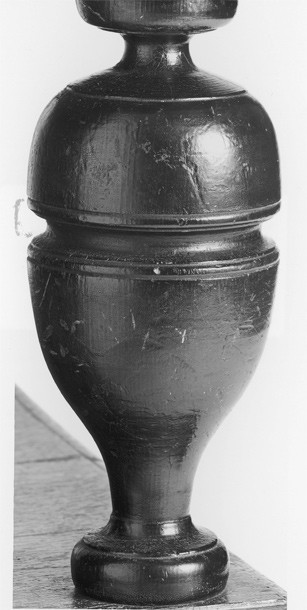
Detail of the lower right pillar of the cupboard illustrated in fig. 40. These pillars are trapped between rails that have never been disassembled, thus their orientation must be correct. The pillars of the cupboard shown in fig. 27 display a similar orientation.

Detail of the large half-column to the right of the door of the cupboard illustrated in fig. 40.

Detail of the small half-columns to the right of the middle drawer of the cupboard illustrated in fig. 40.

Detail of the half-column to the right of the lower drawer of the cupboard illustrated in fig. 40.

Cupboard, northern Essex County, Massachusetts, 1680–1690. Oak and maple with oak. H. 55 1/2", W. 49 1/8", D. 19 7/8". (Courtesy, Museum of Fine Arts, Boston, bequest of Charles Hitchcock Tyler.) The half-columns were removed and repainted during an early restoration. Some may be in the wrong position and several are replaced. The lower pillars and half-columns on the center drawer lack the pronounced checks (from moisture loss) found on original turnings on the cupboards and are probably replacements.
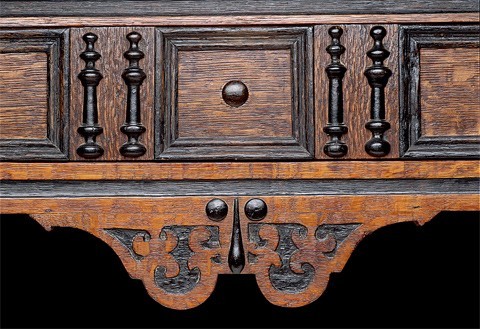
Detail of the bracket on the cupboard illustrated in fig. 47. The bracket is attached with two wrought nails and has carving related to that on the drawer fronts of other pieces in the group.

Detail of the large half-columns to the left of the door of the cupboard illustrated in fig. 47.

Detail of the upper left pillar of the cupboard illustrated in fig. 47.

Detail of the half-columns to the right of the lower drawer of the cupboard illustrated in fig. 47. These Tuscan turnings have more complex finials than the ones on the Perkins cupboard (fig. 36 ).

Detail of the large half-column at the right rear corner of the storage compartment of the cupboard illustrated in fig. 47.

Chest of drawers, northern Essex County, Massachusetts, 1685. Oak and maple with oak. H. 35 1/2", W. 44", D. 20 1/2". (Courtesy, Brick Store Museum, Kennebunk, Maine, gift of Mrs. William Goedecke, Mrs. William Lamborn, and Mrs. Edwin E. Hooker; photo, Gavin Ashworth.) The brasses are modern and are not in the positions of the original knobs. Several ornaments are missing: two or three appliqués at each end of the second drawer from the top; two appliqués on the center plaque of the third drawer; four groups of three appliqués on the blank spaces between the plaques and carving on the bottom drawer. The latter ornaments resembled the pendants on the arcades of cupboards in the group.
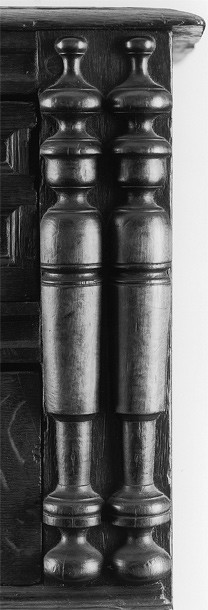
Detail of the large half-columns to the right of the upper drawers of the chest of drawers illustrated in fig. 53. (Photo, Gavin Ashworth.)

Detail of the bracket on the chest of drawers illustrated in fig. 53. (Photo, Gavin Ashworth.)
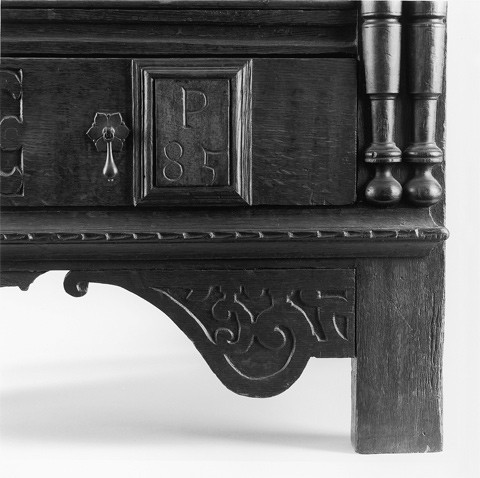
Detail of the bracket adjacent to the right front foot of the chest of drawers illustrated in fig. 53. (Photo, Gavin Ashworth.)
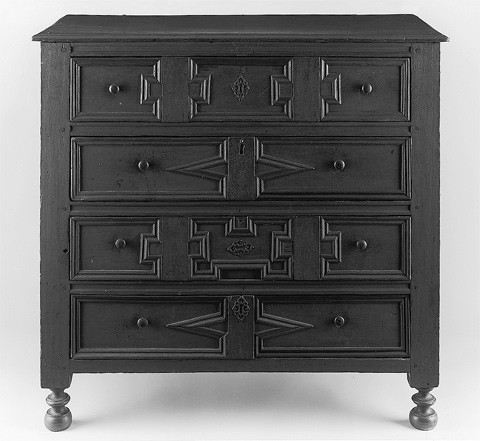
Chest of drawers, northern Essex County, Massachusetts, 1685–1690. Oak and maple with oak and sycamore. H. 39 3/4", W. 41 3/8", D. 20". (Courtesy, North Andover Historical Society, Samuel Dale Stevens Collection; photo, Gavin Ashworth.) The chest originally had four pairs of medium-sized half-columns on the stiles and small half-columns on the rectangular plaques of the drawers. The larger examples probably resembled those on the Capen chest (figs. 53, 54). The locks and brass escutcheons are old, but not original. They could not have been installed on the second and fourth drawers while the small half-columns were in place.
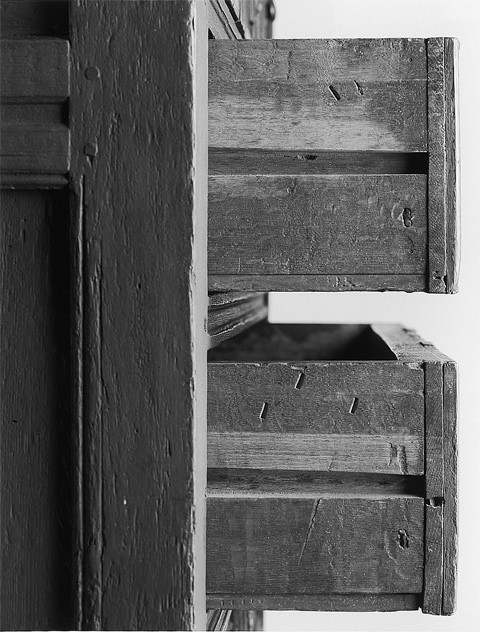
Detail showing two of the four installation marks chiseled on the drawer sides of the chest of drawers illustrated in fig. 57. (Photo, Gavin Ashworth.)
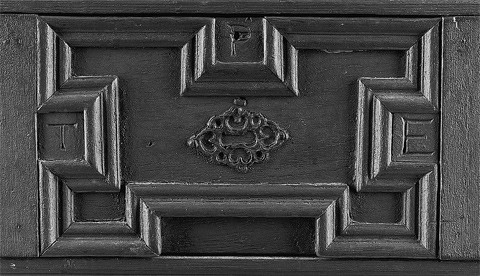
Detail of the crosseted panel on the third drawer of the chest of drawers illustrated in fig. 57. (Photo, Gavin Ashworth.)

Detail of a V-shaped crosset on the second drawer of the chest of drawers illustrated in fig. 57. (Photo, Gavin Ashworth.)
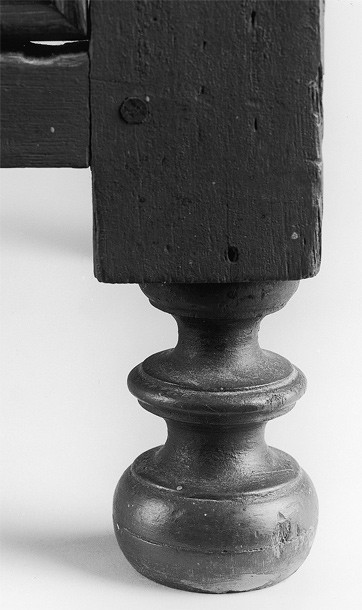
Detail of the right front foot of the chest of drawers illustrated in fig. 57. (Photo, Gavin Ashworth.)
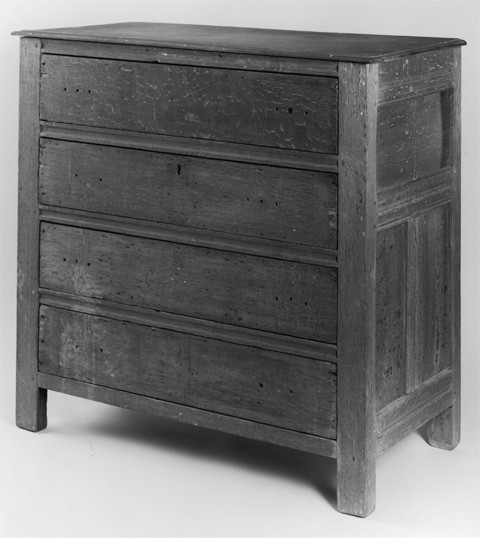
Chest of drawers, northern Essex County, Massachusetts, 1685–1690. Oak with sycamore and oak. H. 39 3/4", W. 41 1/8", D. 20 1/4". (Private collection; photo, Gavin Ashworth.) The sides of the drawers have numerical alignment marks like those on the chest illustrated in fig. 57.
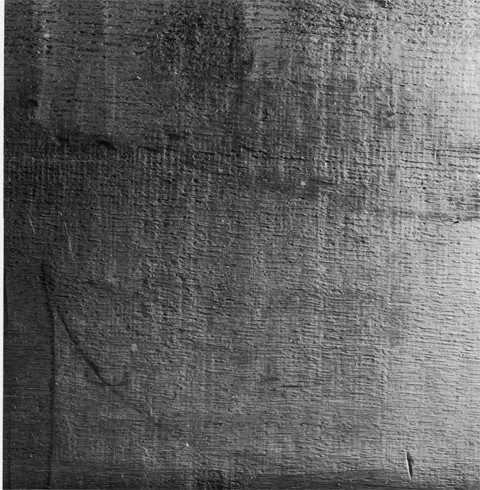
Detail of the water-sawn interior surface of the top board of the chest of drawers illustrated in fig. 62.
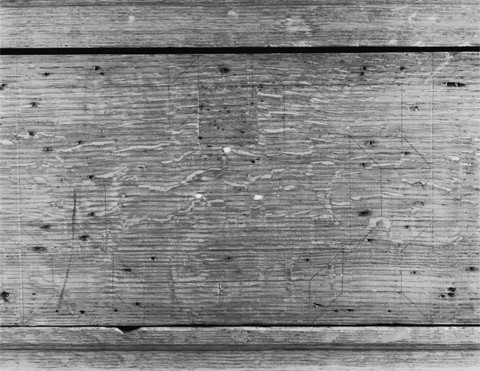
Detail showing the position of the moldings on the upper drawer of the chest of drawers illustrated in fig. 62. (Photo, Gavin Ashworth.)
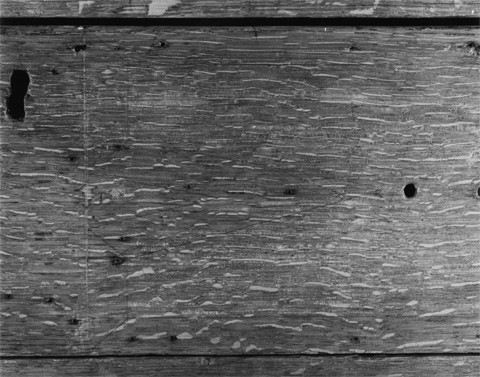
Detail showing the position of the moldings on the second drawer of the chest of drawers illustrated in fig. 62. (Photo, Gavin Ashworth.)
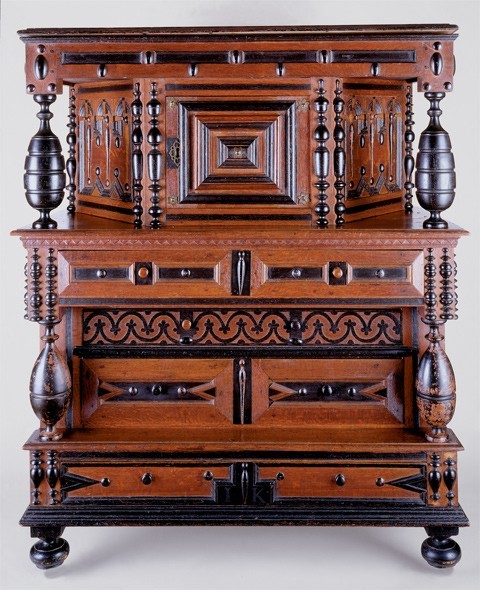
Cupboard, northern Essex County, Massachusetts, 1685–1690. Oak and maple with oak and pine. H. 58", W. 49 1/8", D. 23". (Courtesy, Massachusetts Historical Society, gift of Mrs. J. B. Paine; photo, Gavin Ashworth.) This cupboard is the most intact example in the Essex County group. The bracket under the bottom rail is missing; there are minor losses and replacements of applied ornament; and the paint is relatively modern.

Detail of the central plaque, initials, half-column, and bosses on the bottom drawer of the cupboard illustrated in fig. 66. (Courtesy, Massachusetts Historical Society, photo, Gavin Ashworth.) The incised initials are filled with mastic.
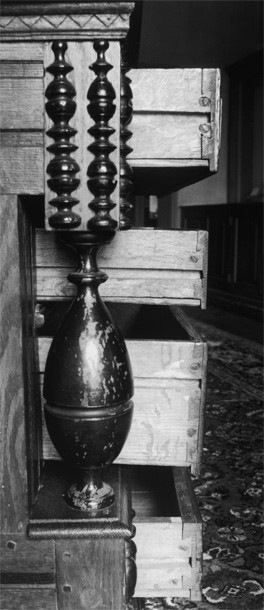
Detail showing the dovetails on four drawers of the cupboard illustrated in fig. 66. (Courtesy, Massachusetts Historical Society, photo, Peter Follansbee.)
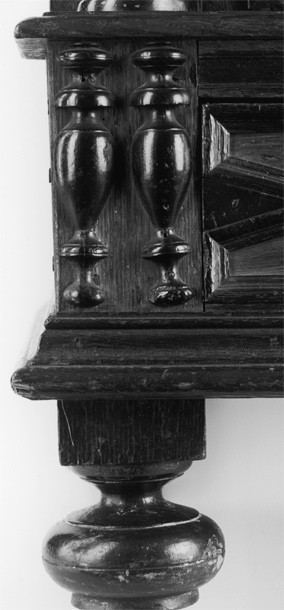
Detail of the left front foot, base molding, and lower half-columns on the cupboard illustrated in fig. 66. (Courtesy, Massachusetts Historical Society, photo, Gavin Ashworth.) The profile of the half-columns is similar to that of the lower pillars, but inverted.

Drawing showing the construction of the door of the cupboard illustrated in fig. 66. (Drawing, Alan Miller; artwork, Wynne Patterson.)

Detail of the upper left pillar of the cupboard illustrated in fig. 66. (Courtesy, Massachusetts Historical Society, photo, Gavin Ashworth.)
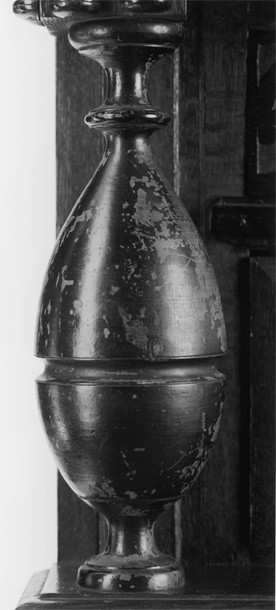
Detail of the lower left pillar of the
cupboard illustrated in fig. 66. (Courtesy, Massachusetts Historical Society, photo, Gavin Ashworth.)
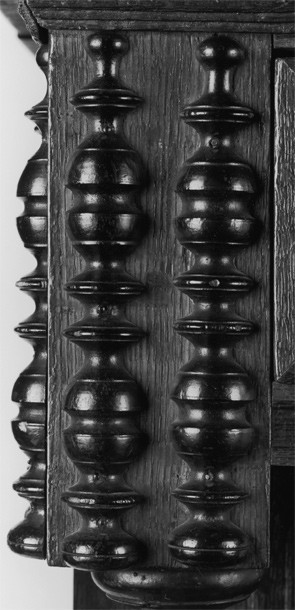
Detail of the small half-columns to the left of the center drawer of the cupboard illustrated in fig. 66. ( Courtesy, Massachusetts Historical Society, photo, Gavin Ashworth.)

Detail of the large half-columns to the left of the door of the cupboard illustrated in fig. 66. (Courtesy, Massachusetts Historical Society, photo, Gavin Ashworth.)
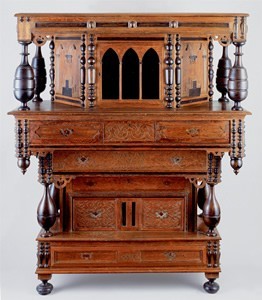
Cupboard, northern Essex County, Massachusetts, 1685–1690. Oak and maple with oak and pine. H. 61 3/4", W. 51 3/4", D. 21 5/8". (Courtesy, Currier Museum of Art, Manchester, New Hampshire, bequest of William G. Berry, 1943.8; photo, Gavin Ashworth.) The backboards of the upper section are replaced, the floorboards of the storage compartment are missing, and a new soffit seals the entire cornice. The latter replacement changed the height of the upper case, requiring the addition of small spacer blocks between the tops of the pillars and the cornice. The gothic door appears to have been added during the nineteenth century. Its arcade resembles those found on North Shore and Portsmouth furniture of the Federal period. The molding flanking the lunette carving on the top drawer is replaced and the third drawer and bottom drawer are completely new. The drawers originally had dovetails. Evidence suggests that the joints resembled those on the drawers of the Sawyer cupboard (fig. 66) and the example shown in figure 85. All of the moldings and appliqués flanking the carving and on the replaced center plaque of the fourth drawer are missing, and base molding is replaced. The moldings probably resembled those on the first, third, and fourth drawers of the Sawyer cupboard. The pendants, middle brackets and several half-columns, bosses, and pendant appliqués from the arcades are also missing.

Detail of the right front pillar of the upper case of the cupboard illustrated in fig. 75. (Courtesy, Currier Museum of Art, Manchester, New Hampshire, bequest of William G. Berry, 1943.8; photo, Gavin Ashworth.)

Detail of the right front pillar of the lower case of the cupboard illustrated in fig. 75. (Courtesy, Currier Museum of Art, Manchester, New Hampshire, bequest of William G. Berry, 1943.8; photo, Gavin Ashworth.) The pillars at the rear have simple unadorned balusters.
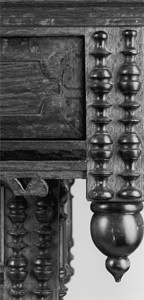
Detail of a bracket fragment and the small half-columns to the right of the top drawer of the cupboard illustrated in fig. 75. (Courtesy, Currier Museum of Art, Manchester, New Hampshire, bequest of William G. Berry, 1943.8; photo, Gavin Ashworth.) The original brackets are tenoned into the front stiles and nailed to the lower edge of the front rail.

Detail of the half-columns to the right of the door of the cupboard illustrated in fig. 75. (Courtesy, Currier Museum of Art, Manchester, New Hampshire, bequest of William G. Berry, 1943.8; photo, Gavin Ashworth.)

Detail of the small half-columns to the right of the bottom drawer of the cupboard illustrated in fig. 75. (Courtesy, Currier Museum of Art, Manchester, New Hampshire, bequest of William G. Berry, 1943.8; photo, Gavin Ashworth.)
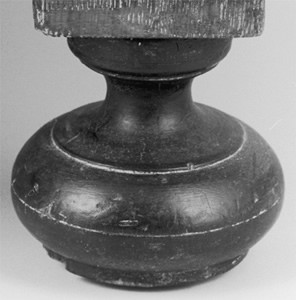
Detail of the right front foot of the cupboard illustrated in fig. 75. (Courtesy, Currier Museum of Art, Manchester, New Hampshire, bequest of William G. Berry, 1943.8; photo, Gavin Ashworth.) The front feet are made of maple and tenoned to the oak posts. The rear feet are integral and have different turning sequences.

Detail of the back of the cupboard illustrated in fig. 75. (Courtesy, Currier Museum of Art, Manchester, New Hampshire, bequest of William G. Berry, 1943.8; photo, Gavin Ashworth.)
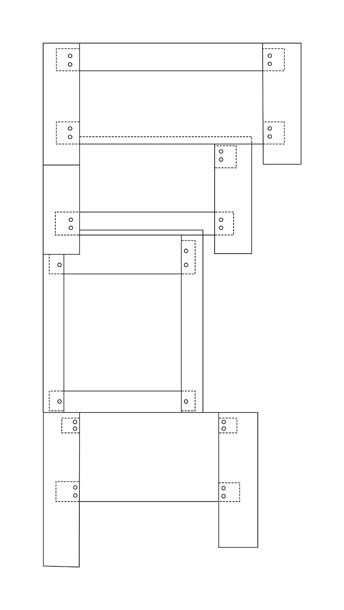
Drawing showing the framing of the side of the lower case of the cupboard illustrated in fig. 75. (Drawing, Peter Follansbee; artwork, Wynne Patterson.)

Drawing showing the framing of the front of the lower case of the cupboard illustrated in fig. 75. (Drawing, Peter Follansbee; artwork, Wynne Patterson.)
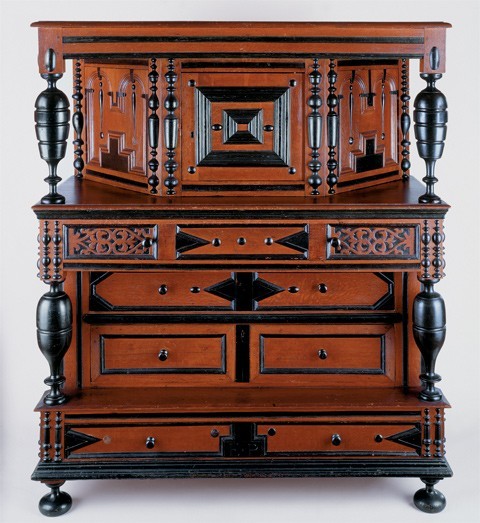
Cupboard, northern Essex County, Massachusetts, 1685–1690. Oak and maple with oak and pine. H. 57", W. 48", D. 21". (Courtesy, Braintree Historical Society, gift of Constance Stoner Leggett; photo, Gavin Ashworth.) The drawers are rebuilt, but saw kerfs indicate that they had dovetails like those on the Sawyer cupboard. The tops of the upper and lower sections, the shallow shelf above the bottom drawer, and the feet are replacements.

Detail of the lower left pillar of the cupboard illustrated in fig. 85. (Photo, Gavin Ashworth.)

Detail of the upper left pillar of the cupboard illustrated in fig. 85. (Photo, Gavin Ashworth.)

Detail of the half-columns to the right of the upper drawer of the cupboard illustrated in fig. 85. (Photo, Gavin Ashworth.)
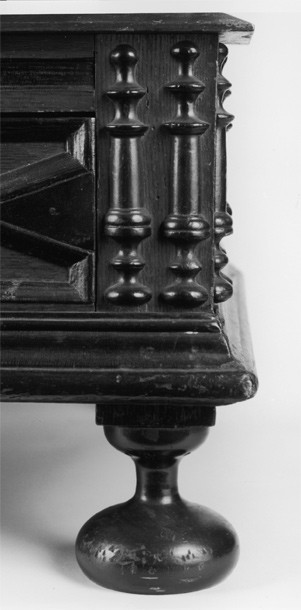
Detail of the half columns to the right of the lower drawer of the cupboard illustrated in fig. 85. (Photo, Gavin Ashworth.)
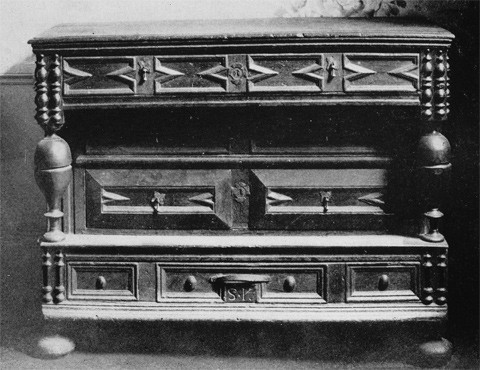
Base of a cupboard, northern Essex County, Massachusetts, 1685–1690. Oak and maple. Dimensions not recorded. (Wallace Nutting, Furniture Treasury [Framingham, Mass.: Old America Co., 1928], pl. 445.) The base molding and astragal element between the second and third drawers are repeated on other cupboards from the same shop (see fig. 66).

Cupboard, northern Essex County, Massachusetts, 1685–1690. Oak and maple with oak and pine. H. 58 3/4", W. 48 1/2", D. 19 3/8". (Museum of Fine Arts, Boston, gift of Maurice Geeraerts in memory of Mr. and Mrs. William H. Robeson.) The diamond-shaped applied frame on the upper door, knobs, and feet are replacements. The door probably had moldings similar to those on the door of the cupboard illustrated in figure 85, but in a diamond-shape configuration.
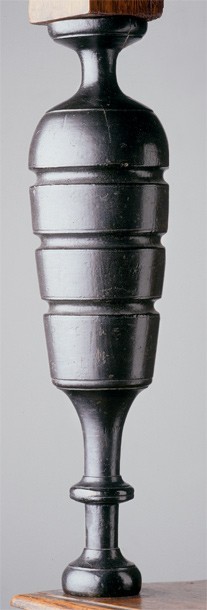
Detail of the upper left pillar of the cupboard illustrated in fig. 91.

Detail of the lower left pillar of the cupboard illustrated in fig. 91.
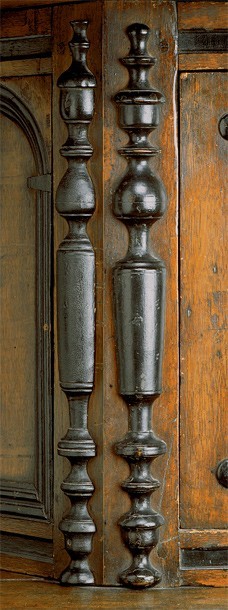
Detail of the large half-columns to the left of the upper door of the cupboard illustrated in fig. 91.

Detail of the large half-column on the right rear corner of the upper storage compartment of the cupboard illustrated in fig. 91.
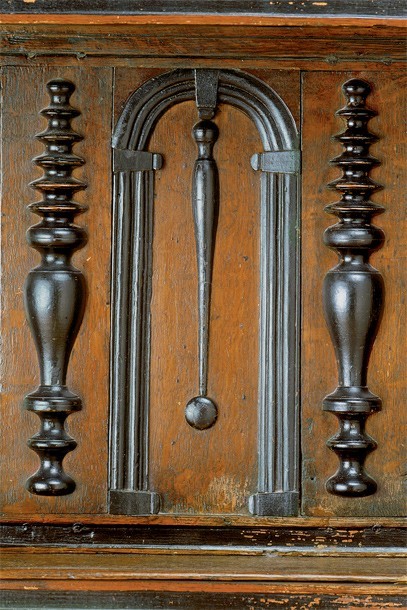
Detail of the large half-columns between the doors of the lower case of the cupboard illustrated in fig. 91.
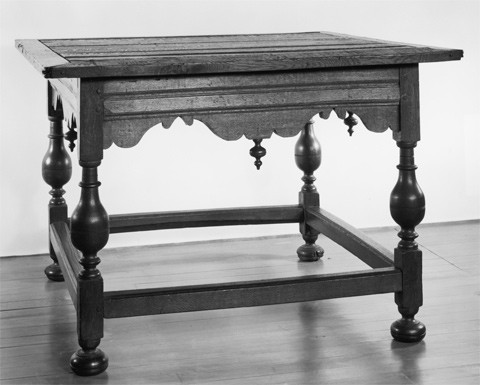
Square table, northern Essex County, Massachusetts, 1685–1690. Oak. H. 31 5/8", W. 46", D. 45 3/8". (Courtesy, Wadsworth Atheneum, Wallace Nutting Collection, gift of J. Pierpont Morgan.) The top surface has been planed and sanded, and the pendants and stretchers are replacements. The original pendants may have resembled those on the frieze of the leaf table illustrated in fig. 22.
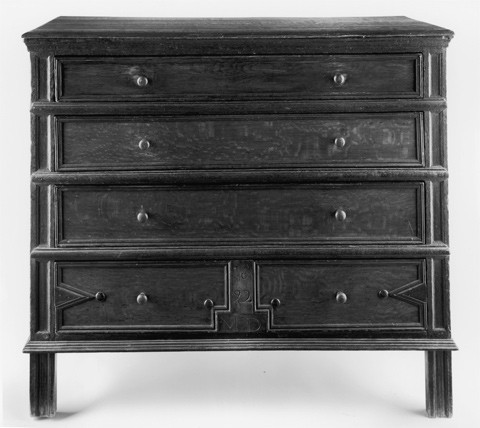
Chest of drawers, northern Essex County, Massachusetts, dated 1692. Oak and maple with oak and pine. H. 40 7/8", W. 45 1/8", D. 18 3/4". (Private collection; photo, Gavin Ashworth.) The top is replaced.

Dressoir, possibly Paris, 1590–1600. Illustrated in Edouard Baldus, comp., Oeuvre de Jacques Androuet dit Du Cerceau (1870), pl. 25. (Courtesy, Winterthur Museum.)

Base of a cupboard, England, 1625–1675. Oak and other unidentified woods. H. 37", W. 54", depth not recorded. Illustrated in Sotheby’s, Selected Pieces from the Cold Overton Hall Collections of Oak and Early Furniture, London, October 10, 1986, lot 87.
